
| Version | Summary | Created by | Modification | Content Size | Created at | Operation |
|---|---|---|---|---|---|---|
| 1 | Beatrix Zheng | -- | 2450 | 2022-10-13 01:33:57 | | | |
| 2 | Beatrix Zheng | + 1 word(s) | 2451 | 2022-11-30 04:16:34 | | |
Video Upload Options
The Boeing Starliner (CST-100 - Crew Space Transportation-100) is a crew capsule manufactured by Boeing as its participation in NASA's Commercial Crew Development (CCDev) program. Its primary purpose is to transport crew to the International Space Station (ISS) and to private space stations such as the proposed Bigelow Aerospace Commercial Space Station. The capsule has a diameter of 4.56 meters (15.0 ft), which is slightly larger than the Apollo command module and smaller than the Orion capsule. The Boeing Starliner is to support larger crews of up to seven people and is being designed to be able to remain in-orbit for up to seven months with reusability of up to ten missions. It is designed to be compatible with four launch vehicles: Atlas V, Delta IV, Falcon 9, and Vulcan. In the first phase of its CCDev program NASA awarded Boeing US$18 million in 2010 for preliminary development of the spacecraft. In the second phase Boeing was awarded a $93 million contract in 2011 for further spacecraft development. On 3 August 2012, NASA announced the award of $460 million to Boeing to continue work on the CST-100 under the Commercial Crew Integrated Capability (CCiCap) Program. On 16 September 2014, NASA selected the Boeing CST-100, along with SpaceX's Crew Dragon, for the Commercial Crew Transportation Capability (CCtCap) program, with an award of $4.2 billion. On 30 July 2019, NASA had no specific dates for Commercial Crew launches, stating that this was under review pending a leadership change. The Boeing Starliner Orbital Flight Test (uncrewed test flight) launched with the Atlas V N22, on 20 December 2019 from SLC-41 at Cape Canaveral Air Force Station , Florida. During the test, the Starliner experienced an anomaly that precluded a docking with the International Space Station. Two days after launch, on 22 December 2019 at 07:58 EST (12:58 UTC), with the successful landing at White Sands, New Mexico, the Boeing Starliner Calypso became the first-ever, crew-capable space capsule to make a land-based touchdown in the United States.
1. Background

The design draws upon Boeing's experience with NASA's Apollo, Space Shuttle and ISS programs as well as the Orbital Express project sponsored by the Department of Defense.[1] The CST-100 has no Orion heritage, but it is sometimes confused with the earlier and similar Orion-derived Orion Lite proposal that Bigelow Aerospace was reportedly working on with technical assistance from Lockheed Martin.[2] It will use the NASA Docking System for docking[3][4][5] and use the Boeing Lightweight Ablator for its heatshield.[6] The Starliner's solar cells will provide more than 2,900 watts of electricity, will be placed on top of the micro-meteoroid debris shield located at the bottom of the spacecraft's service module.[7]
It is designed to be compatible with multiple launch vehicles, including the Atlas V, Delta IV, and Falcon 9, as well as the planned Vulcan.[8][9] Unlike earlier U.S. space capsules, the CST-100 will make airbag-cushioned landings on the ground rather than into water. Five landing areas are planned in the Western United States, which will give the CST-100 about 450 landing opportunities every year.[10]
The CST-100 includes one space tourist seat, and the Boeing contract with NASA allows Boeing to price and sell passage to low Earth orbit on that seat.[11]
2. Development
The CST-100 name was first used when the capsule was revealed to the public by Bigelow Aerospace CEO Robert Bigelow in June 2010.[12] The letters CST stand for Crew Space Transportation.[13] Although it has been reported that the number 100 in the name stands for 100 km, the height of the Kármán line which is one of several definitions of the boundary of space,[14][15] the naming was in fact an arbitrary designation created by the corporate office. The Rocketdyne RS-88 (Bantam) engine will be used for its launch escape system.[16]
Receiving the full fixed-price payments for the CCDev Phase 1 Space Act Agreement required a set of specific milestones to be met during 2010:[17][needs update]
- Trade study and down-select between pusher-type and tractor-style launch escape system
- System definition review
- Abort System Hardware Demonstration Test
- Base Heat Shield Fabrication Demonstration
- Avionics Systems Integration Facility demonstration
- CM Pressure Shell Fabrication Demonstration
- Landing System Demonstration (drop test and water uprighting test)
- Life Support Air Revitalization demonstration
- Autonomous Rendezvous and Docking (AR&D) hardware/software demonstration
- Crew Module Mockup demonstration
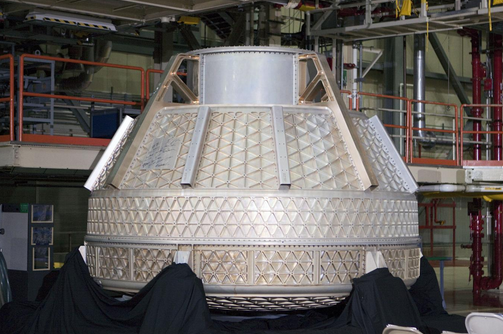
In July 2010, Boeing stated that the capsule could be operational in 2015 with sufficient near-term approvals and funding, but also indicated they would proceed with development of the CST-100 only if NASA implemented the commercial crew transport initiative that was announced by the Obama administration in its FY11 budget request. Boeing executive Roger Krone stated that NASA investment would allow Boeing to close the business case, while this would be very difficult without NASA. In addition a second destination besides the ISS would be needed to close the business case and Krone said that cooperation with Bigelow was crucial for this.[1]
Boeing was awarded a $92.3 million contract by NASA in April 2011 to continue to develop the CST-100 under CCDev phase 2.[18] On August 3, 2012, NASA announced the award of $460 million to Boeing to continue work on the CST-100 under the Commercial Crew Integrated Capability (CCiCap) Program.[19]
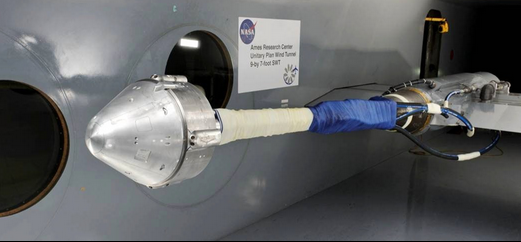
On October 31, 2011, NASA announced that through a partnership with Space Florida, the Orbiter Processing Facility-3 at Kennedy Space Center would be leased to Boeing for manufacture and test of CST-100 spacecraft.[20]
On September 16, 2014, NASA chose Boeing (CST-100) and SpaceX (Dragon V2) as the two companies that will be funded to develop systems to transport U.S. government crews to and from the International Space Station. Boeing won a $4.2 billion contract to complete and certify CST-100 spacecraft by 2017, while SpaceX won a $2.6 billion contract to complete and certify their crewed Dragon spacecraft. The contracts include at least one crewed flight test with at least one NASA astronaut aboard. Once the Starliner achieves NASA certification, the contract requires Boeing to conduct at least two, and as many as six, crewed missions to the space station.[21] NASA's William H. Gerstenmaier considers the CST-100 proposal as stronger than the two others.[22]
Part of the agreement with NASA allows Boeing to sell seats for space tourists. Boeing proposed including one seat per flight for a space flight participant at a price that would be competitive with what Roscosmos charges tourists.[23]
On September 4, 2015, Boeing announced that the CST-100 would officially be called the CST-100 Starliner, a name that follows the conventions of the 787 Dreamliner produced by Boeing Commercial Airplanes.[24] In November 2015, NASA announced it had dropped Boeing from consideration in the multibillion-dollar Commercial Resupply Services second-phase competition to fly cargo to the International Space Station.[25]
In May 2016, Boeing delayed its first scheduled CST-100 launch from 2017 to early 2018.[26][27] Then in October 2016, Boeing delayed its program by six months, from early 2018 to late 2018, following supplier holdups and a production problem on the second CST-100. By 2016, they were hoping to fly NASA astronauts to the ISS by December 2018.[26][28]
In April 2018, NASA suggested the first planned two-person flight of the CST-100 Starliner, slated for November 2018, was now likely to occur in 2019 or 2020. If the delays are maintained it would be expected to carry one additional crew member and extra supplies. Instead of staying for two weeks as originally planned, NASA said the expanded crew could stay at the station for as long as six months as a normal rotational flight.[29]
3. Testing
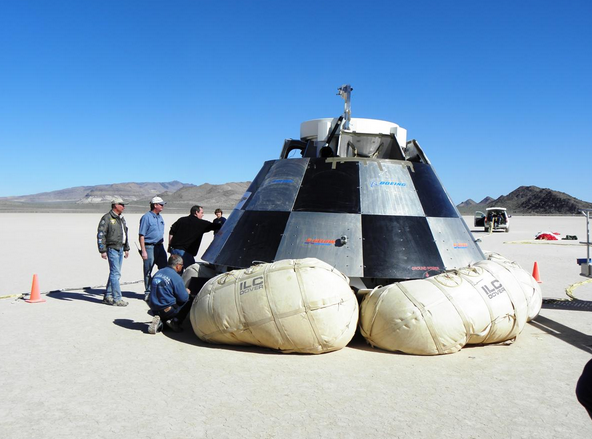
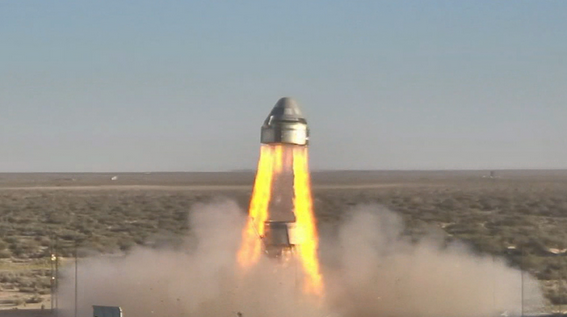
A variety of validation tests have been underway on test articles since 2011.
In September 2011, Boeing announced the completion of a set of ground drop tests to validate the design of the airbag cushioning system. The airbags are located underneath the heat shield of the CST-100, which is designed to be separated from the capsule while under parachute descent at about 5,000 feet (1,500 m) altitude. The airbags are deployed by filling with a mixture of compressed nitrogen and oxygen gas, not with the pyro-explosive mixture sometimes used in automotive airbags. The tests were carried out in the Mojave Desert of southeast California , at ground speeds between 10 and 30 miles per hour (16 and 48 km/h) in order to simulate crosswind conditions at the time of landing. Bigelow Aerospace built the mobile test rig and conducted the tests.[13]
In April 2012, Boeing dropped a mock-up of its CST-100 commercial crew capsule over the Nevada desert at the Delamar Dry Lake near Alamo, Nevada, successfully testing the craft's three main landing parachutes from 11,000 feet (3,400 m).[30]
In August 2013, Boeing announced that two NASA astronauts evaluated communications, ergonomics, and crew-interface aspects of the CST-100, showing how future astronauts will operate in the spacecraft as it transports them to the International Space Station and other low Earth orbit destinations.[31]
Boeing reported in May 2016 that its test schedule would slip by eight months in order to reduce the mass of the spacecraft and aerodynamics issues anticipated during launch and ascent on the Atlas V rocket.[32] The Orbital Flight Test is scheduled for spring 2019. The booster for this Orbital Flight Test, an Atlas V N22 rocket, is being assembled at ULA's facility at Decatur, Alabama.[33] The first crewed flight (Boe-CFT) is scheduled for summer 2019, depending on test results from Boe-OFT. It is planned to last 14 days and carry one NASA astronaut and one Boeing test pilot to the ISS.[34] On April 5, 2018, NASA announced that the first planned two-person flight, originally slated for November 2018, is now likely to occur in 2019 or 2020. If this delay occurs the mission could be expected to carry one additional crew member and supplies. NASA said the expanded crew could stay at the station for as long as six months as a normal rotational flight. This is due to the ending of the agreement for Russia to ferry astronauts to and from the International Space Station in late 2019.[35] NASA has named its first Commercial Crew astronaut cadre of four veteran astronauts to work with SpaceX and Boeing: Robert Behnken, Eric Boe, Sunita Williams, and Douglas Hurley.[36] In July 2018 Boeing announced the assignment of former NASA astronaut Chris Ferguson to the Boe-CFT mission.
In July 2018, a test anomaly was reported in which there was a hypergolic propellant leak due to several faulty abort system valves. Consequentially the first unpiloted orbital mission was delayed to April 2019, and the first crew launch rescheduled to August 2019.[37][38] In March 2019, Reuters reported these test flights had been delayed by at least three months,[39] and in April Boeing announced that the unpiloted orbital mission is now scheduled for August 2019.[40]
In May 2019, all major hotfire, including simulations of low-altitude abort thruster testing, was completed using a full up service module test article that was "flight-like", meaning that the service module test rig used in the recent hotfire testing included fuel and helium tanks, reaction control system, orbital maneuvering and attitude control thrusters, launch abort engines, and all necessary fuel lines and avionics that the ones that will be used for crewed missions will have. This clears the way for the pad abort test and the subsequent uncrewed and crewed flights later.[41]
A pad abort test took place on November 4, 2019.[42] The capsule accelerated away from its pad, but then one of the three parachutes failed to deploy and the capsule landed with only two parachutes.[43][44] Landing was however deemed safe, and the test a success. Boeing did not expect the malfunction of one parachute to affect the Starliner development schedule.[45]
3.1. First Orbital Flight Test
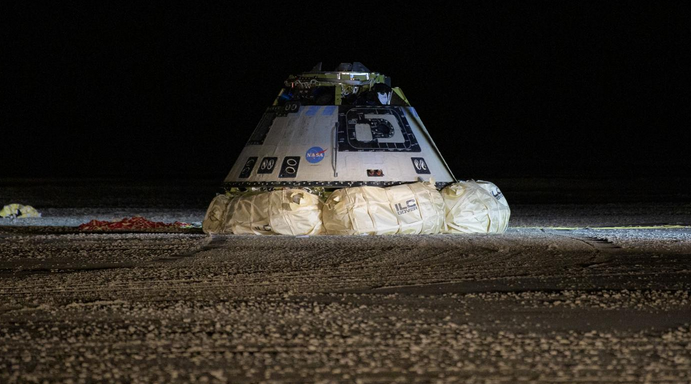
The orbital flight test launched on December 20, 2019, but after deployment, an 11 hour offset in the mission clock of Starliner caused the spacecraft to compute that "it was in an orbital insertion burn", when it was not. This caused the attitude control thrusters to consume more fuel than planned, precluding a docking with the International Space Station.[46][47] The spacecraft landed at New Mexico's White Sands Missile Range two days after launch.[48]. After the successful landing, the spacecraft was named the "Calypso" (after the research vessel RV Calypso for the oceanographic researcher Jacques-Yves Cousteau) by the commander of the USCV-2 mission, NASA astronaut Sunita Williams.[49]
4. List of Operational Spacecraft
As of January 2020, Boeing plans to have three Boeing Starliner spacecraft in service to fulfill the needs of the Commercial Crew Program with each spacecraft expected to be capable of being reused up to ten times with a six month refurbishment time.[50][51]
| Name | Picture | Status | Flights | Scheduled flights | Notes |
|---|---|---|---|---|---|
| Calypso | 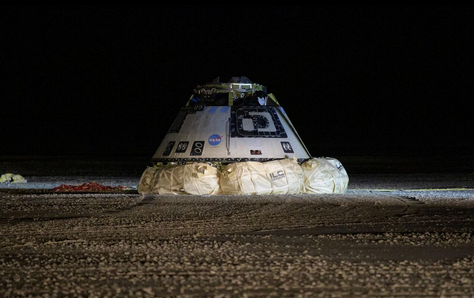 |
Completed | Boe-OFT | 20-22 December 2019 | First Boeing Starliner to fly, was named "Calypso" by its future Commander Sunita Williams following its return from its first flight. |
| TBA | Yet to fly | Boe-CFT | June 2020 | Scheduled to be the first Starliner to fly with crew. | |
| TBA | Yet to fly | N/A | TBA |
5. List of Flights
List includes only completed or currently manifested missions. Launch dates are listed in UTC.
| Mission | Launch date
(UTC) |
Crew | Remarks | Duration | Outcome |
|---|---|---|---|---|---|
| Starliner pad abort test | 4 November 2019, 14:15:00 | N/A | Pad abort test, White Sands Missile Range, New Mexico. One of three parachutes failed to open due to being rigged incorrectly before launch, but parachute system functioned adequately.[45] | 95 Seconds | Success |
| Boe-OFT | 20 December 2019, 11:36:43 | N/A | Uncrewed orbital test flight of Starliner. The mission's main objective of ISS rendezvous was aborted due to software incorrectly keeping mission time, leading to a late orbital insertion burn with excessive fuel expenditure. Starliner landed in New Mexico two days after launch.[48][52][53][54] | 2 days | Partial failure due to a MET anomaly. Rendezvous with ISS cancelled. |
| Boe-CFT | June 2020[55] | Christopher Ferguson Mike Fincke Nicole Mann |
First crewed test flight of Boeing Starliner. | Planned | |
| Boeing Starliner-1[56] | December 2020 |
Sunita Williams Josh Cassada |
First operational flight of Boeing Starliner. This will be a reflight of the OFT vehicle which has been christened 'Calypso' by USCV-2 commander Williams upon its return to earth.[57] | Planned |
6. Crew
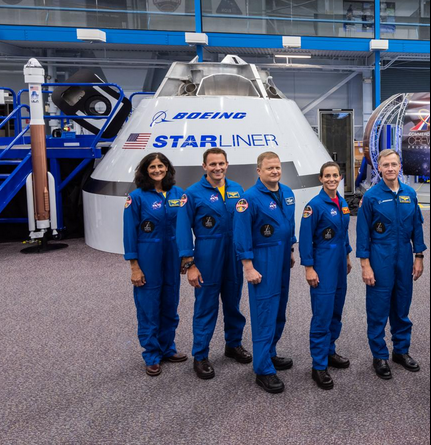
On August 3, 2018, NASA announced the astronauts who will participate in the first Starliner flights.[58][59] Eric Boe was one of those initially selected, but was replaced by Michael Fincke in January 2019 due to "personal medical reasons".[60]
- First test crew - Boe-CFT: Michael Fincke, Christopher Ferguson, Nicole Aunapu Mann
- First mission crew - USCV-2: Sunita Williams, Josh Cassada, Thomas Pesquet, Andrei Borisenko
7. Space Tourism
Space Adventures announced that it has acquired rights to sell tickets to the ISS on board the Boeing Starliner once operational flights begin.[61]
8. Technology Partners
- Aerojet Rocketdyne
- Airborne Systems
- Alliant Techsystems
- Bigelow Aerospace
- Samsung
- Spincraft
References
- Clark, Stephen (July 21, 2010). "Boeing space capsule could be operational by 2015". Spaceflight Now. http://www.spaceflightnow.com/news/n1007/21boeing/. Retrieved September 18, 2011.
- Klamper, Amy (August 14, 2009). "Company pitches 'lite' spaceship to NASA". NBC News. http://www.nbcnews.com/id/32418057/ns/technology_and_science-space/. Retrieved September 7, 2009.
- Grondin, Yves-A. (August 5, 2013). "NASA Outlines its Plans for Commercial Crew Certification". NASA Spaceflight. http://www.nasaspaceflight.com/2013/08/nasa-outlines-plans-commercial-crew-certification/.
- Commercial Space Flight Panel. YouTube.com. SpaceUp Houston. 2011. https://www.youtube.com/watch?v=yGZWIR0Prhk&t=26m57s
- Messier, Doug (March 23, 2011). "Update on Boeing CST-100 Crew Program". Parabolic Arc. http://www.parabolicarc.com/2011/03/23/22339/.
- Latrell, Joe (July 28, 2015). "Boeing's CST-100 takes shape at former NASA facility". Spaceflight Insider. http://www.spaceflightinsider.com/missions/commercial/boeings-cst-100-takes-shape-at-former-nasa-facility/. Retrieved August 3, 2018.
- "Spectrolab Solar Cells to Power Boeing's Starliner Spacecraft". November 17, 2016. http://www.compoundsemi.com/spectrolab-solar-cells-power-boeings-starliner-spacecraft/.
- Lindenmoyer, Alan (2010). "Commercial Crew and Cargo Program". 13th Annual FAA Commercial Space Transportation Conference. February 10–11, 2010. Arlington, Virginia.. Archived from the original on March 5, 2010. https://web.archive.org/web/20100305034240/http://www.aiaa.org/pdf/industry/presentations/Lindenmoyer_C3PO.pdf.
- Crew Dragon and Starliner: A Look at the Upcoming Astronaut Taxis. Mike Wall, Space.com. August 3, 2018. https://www.space.com/41367-commercial-crew-spacecraft-starliner-dragon.html
- Clark, Stephen (September 22, 2015). "Boeing identifies CST-100 prime landing sites". Spaceflight Now. https://spaceflightnow.com/2015/09/22/boeing-identifies-cst-100-prime-landing-sites/. Retrieved August 5, 2018.
- "Boeing space taxi has tourist seat". Thomson Reuters. Canadian Broadcasting Company. September 18, 2014. http://www.cbc.ca/news/technology/boeing-space-taxi-has-tourist-seat-1.2770088. Retrieved January 7, 2017.
- Gedmark, John; Gold, Mike (June 16, 2010). "Bigelow Aerospace Joins the Commercial Spaceflight Federation" (Press release). Commercial Spaceflight Federation. http://www.commercialspaceflight.org/2010/06/bigelow-aerospace-joins-the-commercial-spaceflight-federation/
- Memi, Edmund G. (September 12, 2011). "Space capsule tests aim to ensure safe landings". Boeing. Archived from the original on September 24, 2011. https://web.archive.org/web/20110924163725/http://www.boeing.com/Features/2011/09/bds_cst_100_airbag_09_12_11.html. Retrieved September 18, 2011.
- Memi, Edmund G.; Morgan, Adam K. (July 19, 2010). "Boeing CST-100 Spacecraft to Provide Commercial Crew Transportation Services" (Press release). Boeing. http://boeing.mediaroom.com/index.php?s=20295&item=1323
- Chow, Denise (July 19, 2010). "New Spaceship Could Fly People to Private Space Stations". Space.com. http://www.space.com/8785-spaceship-fly-people-private-space-stations.html.
- Test of Rocketdyne abort motor for Boeing crew capsule. YouTube.com. Retrieved November 24, 2011. https://www.youtube.com/watch?v=mOv1ew1GPKc
- "Space Act Agreement Between National Aeronautics and Space Administration and The Boeing Company for Commercial Crew Development (CCDev)". NASA. February 2010. http://www.nasa.gov/centers/johnson/pdf/444144main_NNJ10TA03S_boeing_saa.pdf.
- Dean, James (April 18, 2011). "NASA awards $270 million for commercial crew efforts". Florida Today. Archived from the original on April 19, 2011. https://web.archive.org/web/20110419234227/http://space.flatoday.net/2011/04/nasa-awards-270-million-for-commercial.html.
- "Boeing, SpaceX and Sierra Nevada Win CCiCAP Awards". SpaceNews. August 3, 2012. http://spacenews.com/civil/120803-boeing-spacex-sierra-ccicap.html.
- Weaver, David; Curie, Michael; Philman, Amber; Lange, Tina; Korn, Paula (October 31, 2011). "NASA Signs Agreement with Space Florida to Reuse Kennedy Facilities" (Press release). NASA. http://www.nasa.gov/home/hqnews/2011/oct/HQ_11-349_KSC_Agreement.html
- Schierholz, Stephanie; Martin, Stephanie (September 16, 2014). "NASA Chooses American Companies to Transport U.S. Astronauts to International Space Station". NASA. http://www.nasa.gov/press/2014/september/nasa-chooses-american-companies-to-transport-us-astronauts-to-international. Retrieved September 18, 2014.
- Norris, Guy (October 11, 2014). "Why NASA Rejected Sierra Nevada's Commercial Crew Vehicle". Aviation Week. Archived from the original on October 13, 2014. https://web.archive.org/web/20141013135535/http://aviationweek.com/space/why-nasa-rejected-sierra-nevadas-commercial-crew-vehicle. Retrieved October 13, 2014.
- Klotz, Irene (September 17, 2014). "Boeing's 'space taxi' includes seat for a tourist". Reuters. https://www.reuters.com/article/2014/09/17/boeing-space-idUSL1N0RI2XY20140917. Retrieved August 6, 2015.
- Clark, Stephen (September 4, 2015). "Enter the Starliner: Boeing names its commercial spaceship". Spaceflight Now. http://spaceflightnow.com/2015/09/04/boeing-names-its-commercial-spaceship-the-starliner/. Retrieved September 4, 2015.
- Rhian, Jason (November 6, 2015). "NASA delays CRS 2 awards again, drops Boeing from consideration". Spaceflight Insider. http://www.spaceflightinsider.com/missions/commercial/nasa-delays-crs-2-awards-again-drops-boeing-from-consideration/. Retrieved November 21, 2015.
- Berger, Eric (October 11, 2016). "Boeing delays Starliner again, casting doubt on commercial flights in 2018". Ars Technica. https://arstechnica.com/science/2016/10/boeing-delays-starliner-again-casting-doubt-on-commercial-flights-in-2018/. Retrieved April 6, 2018.
- Berger, Eric (May 11, 2016). "Boeing's first crewed Starliner launch slips to 2018". Ars Technica. https://arstechnica.com/science/2016/05/boeings-first-flight-slips-its-now-up-to-spacex-to-wean-nasa-off-russia/. Retrieved April 6, 2018.
- Norris, Guy (October 10, 2016). "Boeing Delays CST-100, Still Targets 2018 ISS Mission". Aviation Week & Space Technology. http://aviationweek.com/new-space/boeing-delays-cst-100-still-targets-2018-iss-mission. Retrieved October 11, 2016.
- Pasztor, Andy (April 5, 2018). "NASA, Boeing Signal Regular Missions to Space Station to Be Delayed". The Wall Street Journal. https://www.wsj.com/articles/nasa-boeing-signal-regular-missions-to-space-station-to-be-delayed-1522984513. Retrieved April 6, 2018.
- Clark, Stephen (April 3, 2012). "Parachutes for Boeing crew capsule tested over Nevada". Spaceflight Now. http://www.spaceflightnow.com/news/n1204/03cst100drop/. Retrieved April 3, 2012.
- "Boeing Space Capsule One Step Closer to Orbit". NYSE Big Stage. August 19, 2013. Archived from the original on October 4, 2013. https://web.archive.org/web/20131004212749/http://nysebigstage.com/articles/boeing-aviationday.
- Foust, Jeff (May 12, 2016). "Boeing delays first crewed CST-100 flight to 2018". SpaceNews. http://spacenews.com/boeing-delays-first-crewed-cst-100-flight-to-2018/.
- Rhian, Jason (January 4, 2018). "Boeing CST-100 Starliner one step closer to flight with completion of DCR". Spaceflight Insider. http://www.spaceflightinsider.com/organizations/boeing/boeing-cst-100-starliner-one-step-closer-flight-completion-dcr/. Retrieved April 8, 2018.
- Bergin, Chris (November 27, 2017). "Boeing Starliner trio preparing for test flights". NASASpaceFlight.com. https://www.nasaspaceflight.com/2017/11/boeing-starliner-trio-test-flights/. Retrieved April 8, 2018.
- Pasztor, Andy (April 5, 2018). "NASA, Boeing Signal Regular Missions to Space Station to Be Delayed". The Wall Street Journal. https://www.wsj.com/articles/nasa-boeing-signal-regular-missions-to-space-station-to-be-delayed-1522984513. Retrieved April 8, 2018.
- Pearlman, Robert Z. (July 9, 2015). "NASA assigns 4 astronauts to commercial Boeing, SpaceX test flights". CollectSpace. http://www.collectspace.com/news/news-070915a-commercial-crew-astronauts.html. Retrieved December 31, 2016.
- "NASA's Commercial Crew Program Target Test Flight Dates". October 4, 2018. https://blogs.nasa.gov/commercialcrew/2018/10/04/nasas-commercial-crew-program-target-test-flight-dates-4/.
- "February 6, 2019 – Commercial Crew Program" (in en-US). https://blogs.nasa.gov/commercialcrew/2019/02/06/.
- Eric M. Johnson (March 20, 2019). "Boeing delays by months test flights for U.S. human space program: sources". Reuters. https://www.reuters.com/article/us-space-boeing/boeing-delays-by-months-test-flights-for-us-human-space-program-sources-idUSKCN1R12QR. Retrieved March 22, 2019.
- Clark, Stephen (April 2, 2019). "Boeing delays first Starliner test flight to August, NASA extends duration of first crew mission". Spaceflight Now. https://spaceflightnow.com/2019/04/02/boeing-confirms-delay-of-first-starliner-crew-capsule-test-flight-to-august/. Retrieved April 3, 2019.
- "Boeing's Starliner crew capsule completes major propulsion test – Spaceflight Now". https://spaceflightnow.com/2019/05/25/boeings-starliner-crew-capsule-completes-major-propulsion-test/.
- "Boeing tests crew capsule escape system – Spaceflight Now" (in en-US). spaceflightnow.com. https://spaceflightnow.com/2019/11/04/boeing-starliner-pad-abort/.
- "Starliner flies for the first time, but one of its parachutes failed to deploy". November 4, 2019. https://arstechnica.com/science/2019/11/starliner-flies-for-the-first-time-but-one-of-its-parachutes-failed-to-deploy/.
- "Boeing statement regarding CST-100 Starliner pad abort test". November 4, 2019. https://boeing.mediaroom.com/2019-11-04-Boeing-statement-regarding-CST-100-Starliner-pad-abort-test. Retrieved November 4, 2019.
- https://spaceflightnow.com/2019/11/04/boeing-starliner-pad-abort/
- "Starliner suffers "off-nominal" orbital insertion after launch". Space News. December 20, 2019. https://spacenews.com/starliner-suffers-off-nominal-orbital-insertion-after-launch/.
- Sheetz, Michael (December 20, 2019). "Boeing Starliner fails mission, can’t reach space station after flying into wrong orbit". CNBC. https://www.cnbc.com/2019/12/20/boeings-starliner-flies-into-wrong-orbit-jeopardizing-trip-to-the-international-space-station.html. Retrieved December 20, 2019.
- Amos, Jonathan (December 20, 2019). "Boeing astronaut ship stalls in orbit.". BBC News. https://www.bbc.com/news/science-environment-50855395.
- Lewis, Marie (December 22, 2019). "Tune in for Starliner Postlanding News Conference.". NASA Commercial Crew Program. https://blogs.nasa.gov/commercialcrew/2019/12/22/tune-in-for-starliner-postlanding-news-conference/.
- https://space.skyrocket.de/doc_sdat/starliner.htmC
- https://www.boeing.com/space/starliner/
- Halaschak, Zachary. "Boeing Starliner spacecraft goes off course and fails mission". https://www.washingtonexaminer.com/news/boeing-starliner-spacecraft-goes-off-course-and-fails-mission. Retrieved December 20, 2019.
- Bridenstine, Jim. "Error: no |title= specified when using {{Cite web}}". https://twitter.com/JimBridenstine/status/1208021843388633090. Retrieved December 20, 2019.
- Gebhardt, Chris. "Starliner suffers mission-shortening failure after successful launch". https://www.nasaspaceflight.com/2019/12/starliner-mission-shortening-failure-successful-launch/. Retrieved December 20, 2019.
- "Launch Schedule". January 17, 2020. https://spaceflightnow.com/launch-schedule/.
- https://www.nasa.gov/specials/ccp-press-kit/main.html
- Williams, Sunita. "Error: no |title= specified when using {{Cite web}}". https://twitter.com/Astro_Suni/status/1208780116630876160. Retrieved December 22, 2019.
- Chavers, Alex (January 9, 2017). "NASA Picks SpaceX and Boeing's First Crew". News Ledge. https://www.newsledge.com/nasa-spacex-boeing-crew/. Retrieved August 3, 2018.
- "NASA Assigns Crews to First Test Flights, Missions on Commercial Spacecraft". NASA. August 3, 2018. https://www.nasa.gov/press-release/nasa-assigns-crews-to-first-test-flights-missions-on-commercial-spacecraft. Retrieved August 3, 2018.
- Gebhardt, Chris (January 22, 2019). "NASA announces test flight crew change for Boeing's Starliner". NASASpaceFlight.com. https://www.nasaspaceflight.com/2019/01/nasa-test-flight-crew-change-boeings-starliner/. Retrieved January 23, 2019.
- "Space Station Experience". http://www.spaceadventures.com/experiences/space-station/.




